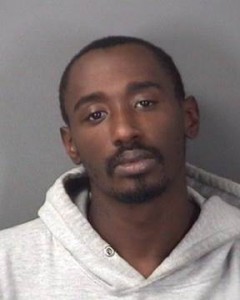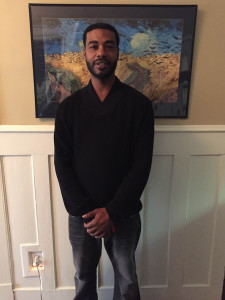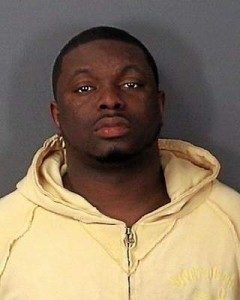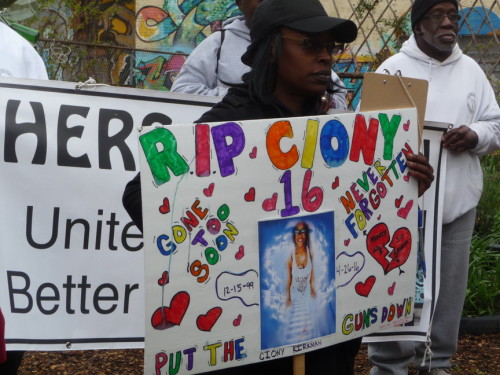Two men were within feet of a Ewing man when he was executed outside of a city bar.
![Prosecutors say this surveillance photo shows Shaheed Brown (left) and Enrico Smalley Jr. minutes before Smalley was gunned down outside of La Guira Bar on July 12, 2014.]()
Prosecutors say this surveillance photo shows Shaheed Brown (left) and Enrico Smalley Jr. minutes before Smalley was gunned down outside of La Guira Bar on July 12, 2014.
One is dead. Another altered his appearance and misled a detective who tried to interview him three times, following the murder of Enrico Smalley Jr., who was gunned around 1:21 a.m. on July 12, 2014 outside of La Guira Bar.
State Police Detective Joseph Itri referred to Rodney Sutphin and Alvie “King” Vereen throughout his time on the stand under cross examination Wednesday.
And like he did at the first trial, defense attorney Edward Heyburn spent much of the day chiseling out a third-party guilt defense. He goaded Itri about drawing up an arrest warrant for Brown within days of the murder, saying he did not have probable cause and had not eliminated Vereen and Sutphin as suspects prior to focusing on his client.
Heyburn’s tactics rubbed Smalley’s family members the wrong way, especially since the men he pointed the finger at were part of Brown’s entourage.
Outside the courtroom, one of Smalley’s relatives remarked that Heyburn was trying some “slippery s---.”
Third-party guilt
Vereen and Michael Becket arrived with Brown outside of La Guira Bar around 1:16 a.m., according to the surveillance tapes shown to jurors.
Vereen is a central figure in Brown’s defense. Heyburn contends Vereen was the real killer based on his behavior and movements prior to Smalley being shot six times, twice in the head, outside of a packed stretch of city bars along North Clinton Avenue.
Vereen was never charged in connection with Smalley’s murder.
Sutphin, whose name precedes him in Trenton because of his notorious uncle, interacted with Brown before Smalley was gunned down. He was killed three months after Smalley’s death.
His murder remains unsolved, and it is unclear if it is linked in any way to Smalley's death.
Authorities got nowhere when they attempted to speak with the men about what they knew about the murder, Itri said.
![State Police Detective Joseph Itri testifies at Shaheed Brown's trial. Gregg Slaboda - The Trentonian]()
State Police Detective Joseph Itri testifies at Shaheed Brown's trial. Gregg Slaboda - The Trentonian
Sutphin lied to detectives about not being at the bar, which authorities did not realize until after they thoroughly reviewed surveillance tapes and spotted Sutphin and Vereen following behind Brown and Smalley moments before shots rang out.
Detectives never confronted Sutphin about the lie. Itri said a second interview was not high on the priority list because Sutphin was uncooperative.
“I wish we had truth serum that made someone cooperate,” Itri said.
Still, no matter how he was plied, led or questioned, Itri never strayed from his convictions that Brown was the shooter. He did not consider Vereen or Sutphin as suspects. He said they were witnesses -- with one caveat.
“If we want to say there’s a conspiracy,” Itri said.
Heyburn cut off the detective before he could finish his answer.
Throughout the day, Heyburn zeroed in on Vereen, re-tracing his movements on the surveillance tapes seconds before Smalley was gunned down.
![Shaheed Brown listens to testimony from State Police Detective Joseph Itri. Gregg Slaboda - The Trentonian]()
Shaheed Brown listens to testimony from State Police Detective Joseph Itri. Gregg Slaboda - The Trentonian
Brown, Vereen and Sutphin huddled together on Poplar Street around 1:20 a.m.
Around the same time, Smalley appeared in the bar vestibule and greeted a man, who handed him a cigarette.
Smalley walked outside where he met with Brown. Raesean Sutphin, Rodney’s brother, and another man known only as "Juice" walked in front of Brown and Smalley.
As they walked down the sidewalk, Brown appeared to use his body to shield his right hand. A black glove was visible from the wrist. The men then stepped out of view of the cameras.
Vereen and Rodney Sutphin followed behind.
Vereen walked with his arms near his waistband as he neared Smalley, though it was unclear if he reached for a handgun, as Heyburn suggested.
Itri shrugged off the defense attorney, saying Vereen’s swinging arms were part of his “normal gait.”
Heyburn blew up the photo and asked Itri if he could tell if Vereen reached for his waistband with his left hand.
“It’s two-dimensional so I can’t tell,” the detective said.
Itri agreed there was no gunfire until Vereen stepped off camera.
The two sparred about whether Vereen appeared to tuck something into his waistband when he reappeared about two seconds later, running toward Poplar Street before stutter-stepping and darting out of sight, into the middle of North Clinton Avenue.
Itri conceded only that Vereen’s arms were tucked in close to his body and not visible to the camera.
The sceneHeyburn tried to bolster his point with the jury by cycling through photos of the shell casings and bullet fragments found outside of La Guira.
Earlier, Heyburn asked the detective about Dr. Raafat Ahmad’s autopsy on Smalley and whether investigators could have used her findings to reconstruct the shooting.
Heyburn contended Ahmad’s findings could have helped a ballistics experts determine where the shooter was when Smalley was shot. Five of the bullets entered Smalley’s body from the left side, Heyburn said.
Itri was noncommittal, asking Heyburn to “hit the definition of trajectory.”
Mum’s the word
Investigators attempted to interview Vereen for the first time in December 2014, five months after Smalley’s death. He was locked up on unrelated charges in Bucks County, Penn., Itri said.
Vereen was uncooperative, telling detectives he was not at the bar when Smalley was killed. That wasn’t true.
Like Brown, who had a clean shaven head when he was arrested in Newark in August 2014, Vereen had also changed his appearance, Itri said.
Both Brown and Vereen had dreadlocks the night of the shooting.
Vereen was only one of the numerous people detectives tracked down and tried to interview in the days and months after the murder.
Earlier in the day, Assistant Prosecutor Brian McCauley ticked off a list of people detectives sought out, including some of Smalley’s friends. Most people were not helpful or said they did not witness the shooting.
Detectives also spoke to the Sutphin brothers, who were at La Guira Bar around the time Smalley was gunned down.
Raesean Sutphin spoke to detectives around about 17 hours after the murder. He said he had stepped into an alleyway to “take a leak,” Itri said, when he heard gunshots.
Raesean Sutphin told investigators he was with a friend, “Juice.” They were captured by surveillance tapes walking in front of Smalley and Brown shortly before the shooting.
Heyburn said in his opening statement the men were an “escort or a block,” insinuating they were involved in a plot to kill Smalley.
Juice looked over his shoulder at Brown and Smalley. He was never identified or interviewed by authorities, Itri said.
Defending his investigation and pointing out the pains he went to ensure he had the right man, Itri said he had “no reason” to believe Raesean Supthin nor Juice was involved in Smalley’s murder.
“The point of my investigation is to find the truth,” he said. “I don’t get any compensation for solving homicides.”
Raesean Sutphin was later one of four people who were arrested and charged with attempted murder for an October 2014 shooting that injured two city residents on St. Joe’s and Girard avenues, about a half-mile from La Guira Bar.
Probable cause
Heyburn launched into his cross examination Wednesday morning by focusing on the information Itri had when he prepared an arrest warrant charging Brown with Smalley’s murder.
Itri filed a probable cause warrant charging Brown with murder two days after the slaying.
McCauley and a judge authorized the arrest warrant, which was based in part on a 911 tape, preliminary findings from Smalley’s autopsy and statements from Raesean Sutphin and former corrections officer Kenneth Crawford.
Some of the information the detective received from Crawford was shown at trial to be untrue.
Crawford acknowledged when he testified this week that portions of the 911 call he made anonymously from a 7-Eleven pay phone on North Olden Avenue about 22 minutes after the shooting were inaccurate and he made assumptions about who was the shooter.
Specifically, Crawford said he saw someone shooting down at another man and identified the shooter as a taller African-American man with dreadlocks who had fled toward North Olden Avenue following the shooting.
Itri visited the 7-Eleven and obtained surveillance that helped lead him to Crawford, who had refused to identify himself to a 911 dispatcher.
Crawford acknowledged he did not see the actual shooting because his view was obstructed by a Lincoln Navigator parked in front of La Guira Bar.
Crawford was sitting in his vehicle across the street from the bar when he was startled by gunshots. He testified this week that when he looked up, he saw the upper body of a man who appeared to be jerking.
“I’m thinking this person may be involved in the gunfire because I see their body doing a little jumping motion each time the gunfire went off,” Crawford said.
The trial resumes Thursday with Itri back on the stand.




















